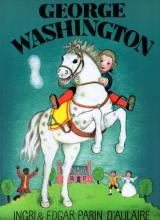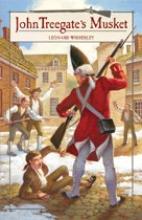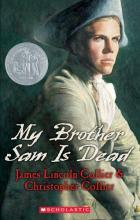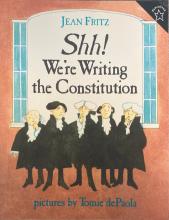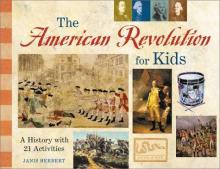History American Revolution Era
And Then What Happened, Paul Revere?
This is a humorous yet informative account of Paul Revere's famous ride to alert the countryside that "the Redcoats" were coming. The details are quite interesting and carefully researched (down to a few details that Paul Revere liked to include when telling the story to his own grandchildren). There are a few slightly annoying details in the illustrations, but I wouldn't consider them serious (e.g. a picture of a Boston scene that includes a picture of a pirate's head – not detailed enough to be gory, but a bit gross) . Fully illustrated (not fabulous illustrations, but they suffice) and appropriate for early grade school.
Boston Tea Party
One of the most famous events leading up to the American Revolution is often not well-understood. Even many history textbooks muddle or even mutilate the facts causing many people to think that those who dumped tea into Boston Harbor on that December night in 1773 were basically looting the ships because they were upset about taxes. The truth is more subtle and a lot more respectable than that and this is a fine book (with lovely pen and ink illustrations) to clear up all the confusion. From the "Adventures in Colonial America" series. 3rd grade and up.
George Washington
It is just like the D'Aulaire's to create a story (complete with beautiful full-color illustrations) that would be interesting and appealing to small children and yet teach more about the character and upbringing of "the Father of Our Country" than most textbooks. The story covers our First President's early childhood – growing up in Colonial America – his adventures (and character) as a young officer during the French and Indian War and, of course, his role in the American Revolution and as president.
Guns for General Washington. A Story of the American Revolution
John Treegate's Musket
My Brother Sam is Dead
My Brother Sam is Dead is the story of a boy whose brother rebels against his father to join the colonial army in the Revolutionary War. There are many good things to recommend about this story and some warnings to give also.
The boy, Tim Meeker, is witness to the chaotic events of the war. The book gives a good description of the confusion of the times with occupying armies and defiant citizens, senseless death and seemingly cruel punishments. Tim's brother, Sam, joins the patriot army against his father's wishes and even returns to steal his father's gun. Sam's father is a staunch loyalist and scandalized by his son's behavior. The father has also had a taste of war in the French and Indian war and does not want his son to have to experience the horror of it. The son thinks he knows better.
As the war progresses, and goods become scarce, armies on both sides resort to commandeering or stealing for food and supplies. Tim's father is arrested as he is bringing a load of supplies to the tavern he runs and Sam is arrested for stealing cows, which he did not steal. Tim's father dies on a British prison ship and Sam is executed by his own army for theft. The scene of the execution is somewhat unsettling as are other scenes like it in the book.
This is definitely an anti-war story. The authors end the book by asking if we might have been able to accomplish independence without a war. Throughout the story the atrocities of war are reflected upon by Tim and there are many quotes by Tim's father about the price of war, such as, "In war, the dead pay the debts of the living." This slant by the author would make a great subject for discussion.
Another very interesting aspect of story is that the rebellion of the son to his father directly parallels the rebellion of the colonies to the father country, England. The exchanges between father and son could be laid right across the colonies and England. Yet another interesting aspect is the irony of the deaths of father and son. Father, as a loyalist, dies in a prison ship as a prisoner of the country he professes and Sam, as a rebel, dies at the end of an firing squad of his fellow patriots. All of these make this book a great vehicle for discussion of author's bias and purpose, of literary devices such as irony and story structure, and finally of the ideas behind the war itself.
However, there is one great drawback to the story. There is an enormous amount of swearing in it, including taking the Lord's name. If it were just once or twice, you might be able to overlook it, but one teacher I know counted and found over fifty instances of swearing. If you want your children to have the experience of the book, you might consider reading it aloud and editing out the swearing as you read. However, there are many other books available which discuss the ideas of the Revolutionary War while avoiding this drawback.
Newbery Honor Book
Shh! We're Writing the Constitution
A surprisingly in-depth account of the characters involved in the writing of the United States' Constitution and many of the fascinating details of life at that time, the struggles involved in such a monumental task, and the somewhat humorous attitudes and actions of our Founding Fathers. Approximately 4th grade reading level, but could be read aloud to younger children (and would be informative for older ones as well).
Silver for General Washington
Silver for General Washington is an engrossing story about twelve-year-old Gil and his sister, Jen, who are living in Valley Forge with their cousins during the occupation of Philadelphia. Before leaving their well-to-do home in Philadelphia, Gil helped his father bury all the family silver in a chest beneath the house. As the winter progresses and conditions grow worse for the poor soldiers, Gil overhears people saying that what's really needed is money to get food and other supplies. Knowing that it's what his father would want (his father is away on war business) Gil decides to sneak back into Philadelphia to recover the silver himself and offer it to General Washington. A nice story that brings to life the struggles and courage present in a critical and difficult time in our country's history that is all too often taken for granted.
Suitable for a family read-aloud or independent reading grades three and up.
The American Revolution for Kids
What is history? A story. In The American Revolution for Kids, Janis Herbert has given us a well written, high interest story. Her style of writing is lively and interesting as wells as fair and impartial – giving us a fair and balanced picture of an emotionally turbulent time. This book offers a good overview of the time period (suitable for putting together a unit study on the time period) or interesting reading for its own sake.
Although the majority of the book follows the development of the war from its onset until its conclusion, Herbert also takes some detours, offering information about other events and people of the time – like a typical colonist and the life of soldier – to give us a sense of day-to-day life and customs of the time. The story doesn't end with the closing of the war; the last chapter discusses the Constitutional Convention through the final ratification of the Constitution.
There are many other extra features in this book:
A timeline sets the stage beginning with the French and Indian War (1754-60), following the development of important battles, explaining important dates along the way and finally ending with Congress adopting the Bill of Rights in 1791.
Spotlight biographies cover such important figures as John Hancock, George Washington, and Nathanael Greene. Other interesting facts are also spotlighted throughout the book, such as how many musket balls were made from the torn down, lead statue of King George.
The 21 Activities noted in the title are sprinkled throughout the text and include making a fringed hunting shirt like one worn by frontiersman Gen. Daniel Morgan, reenacting the Battle of Cowpens, creating a powder horn, sewing a pouch, and baking Boston Brown bread.
The end pages include a glossary, a list of famous Patriots and Redcoats, a list of biographies, the Declaration of Independence, web sites to explore, Revolutionary War Sites to visit in person, a Bibliography, and an index.
I would suggest that families make a point of reading about how Catholics were treated at this time, since this is overlooked in most secular texts. Far from religious toleration, there was a great deal of bigotry at that time, creating mixed feelings for Catholics as to which side they should support.
Sepia and black and white illustrations.



